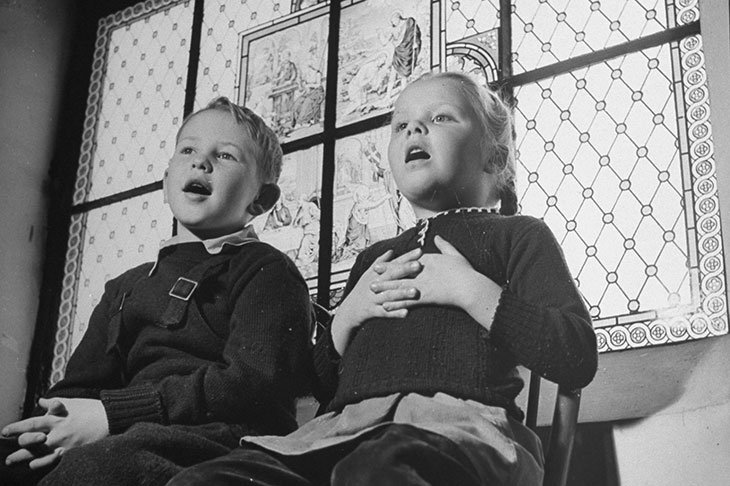‘It’s the same old story — pay or pray,’ said my oldest friend, sardonically, when I told him I was sending my children to a Church of England school. I could hardly blame him for being cynical. He’d known me since we were teenagers, when we were both devout and pious atheists. Yet now I was educating my kids for free, while he was forking out a small fortune to go private. No wonder he felt a bit put out. Since I started going to church again, our friendship has not been quite the same.
For cash-strapped parents, the C of E system is a have-your-cake-and-eat-it solution to an age-old dilemma. Can’t afford school fees? Don’t fancy the look of your local state school? Then go to church, get a letter from your vicar, and bingo — a middle-class education, free of charge.
I can see why my friend felt so disgruntled. The way he saw it, the C of E school system was a racket, a ruse for two-faced mums and dads to get something for nothing. However, my experience of C of E schools, as a pupil and a parent, has been a world away from this stereotype. We all know the case for the prosecution. Here’s the case for the defence.
When I was a kid, my mum took me to our local Anglican church, St Mary’s, in Woolwich in south-east London. I loved that church and so did she, so going to the primary school that shared its name seemed like a natural thing to do. It was a nice school, but it wasn’t remotely posh or difficult to get in to. Then, as now, Woolwich was not the smartest place.
My secondary school, a state grammar, wasn’t a C of E school as such, but the headmaster was an Anglican priest and we had prayers and Bible readings and religious instruction every day. Our RE teacher was a kindly Irish Catholic, who taught us that each and every one of us was unique and loved by God, whoever He was. ‘You are all special,’ he said. I still believe that was the most important thing I learned while I was there.
At university I adopted atheism (it’s easy to be an atheist at university) but as real life began, the church started to draw me back. When I had a breakdown in my early thirties it was an Anglican priest who saved me. I started going to his church, I started taking my son to church, and when the time came for him to go to school I wanted to send him to one where he might meet teachers like those who had helped me.
The reason I tell this story is not because it’s un-usual, but because it’s rather common. The Church of England is famously self-effacing (Anglicans hate to make a fuss) but I’ve met lots of inspiring people in C of E schools, teachers, parents, pupils, who have reinforced my fragile faith, people whose religious roots run a lot deeper than you might think.
My son and daughter went to St Peter’s C of E primary school in Hammersmith. The intake was a fair reflection of this inner-London district: mixed-race, mixed-ability, with a wide range of incomes. It’s a super school and I’m glad they went there, but it wasn’t the most prestigious state school around. There were several non-religious state primaries in the area which were just as highly regarded, maybe more so. However, what set St Peter’s apart, for me, was its Christian ethos, and when we moved out to the suburbs I wanted to find a school with the same outlook on life.
I found a place for my daughter at Bishop Winnington Ingram (aka BWI), a C of E primary in Ruislip. It’s not the most sought-after school in the area and its academic record has been variable, but I’ve never come across more caring teachers. My daughter felt cherished there. After a while a place came up at Whiteheath, a non-religious school with a better reputation. I didn’t want my daughter to leave BWI, but I didn’t want to make her a martyr to my brittle Christianity. I asked her if she’d like to transfer. She said she was happy where she was.
Now she is at Bishop Ramsey, a C of E secondary in Eastcote. It’s a fine school with great teachers and great results, and lots of people want to go there. But just because it’s difficult to get into doesn’t make it elitist. The school is in a smart white suburb, but its racial profile is far more diverse than the area around it. Religious criteria give it a broader intake than the local catchment area ever could.
My own experience has taught me that C of E schools aren’t middle-class enclaves. They aren’t the poshest schools, or even the most high achieving. But if they really are better, on average, than non-religious state schools (and, on balance, I believe they are) then what’s to stop those other state schools copying their Christian principles? Jesus is a prophet in Islam. His teaching is broadly compatible with most major religions, or so it seems to me.
Here’s the real secret about C of E schools: they aren’t doing anything very different from most state schools of yesteryear. They’re still doing the things that other state schools today have forsaken: hymns in assembly, daily prayers and the moral message of the New Testament. You might think this is happy-clappy nonsense, but as a parent, I can’t better the mission statement on the BWI website: ‘The Christian values of service, forgiveness, peace, hope and compassion are our focus this academic year.’






Comments